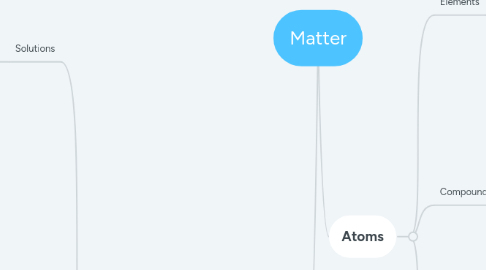
1. Solutions and Suspensions
1.1. Solutions
1.1.1. When we stir solid salt and water, the solid salt cannot be seen. We say that the salt dissolves in the water, or salt is soluble in water.
1.1.2. In a solution, when the solute dissolve, the particles of the solute fill up the spaces between the particles of the solvent and there is no chemical reaction taking place there.
1.1.3. The complete mixing of the solute and solvent particles make a solution homogeneous
1.1.3.1. A homogeneous solution means that the color, density and appearance are the same in every part of the solution
1.1.3.1.1. They also allows light to pass through it when it is placed on a clear transparent cup. Eg: Soap water solution, soda drink
1.1.4. When it is left to stand, it would remain the unchanged
1.2. Suspensions
1.2.1. When insoluble substances are suspended(eg: a solid does not dissolve in a solvent) in a liquid or gas, a suspension is formed (eg: haze, milo)
1.2.2. A suspension is cloudy and heterogeneous(non-homogeneous) that different parts of the suspension has different color, density, appearance
1.2.2.1. When a suspension is left to stand, the insoluble particles will float on top or settle to the bottom after some time as 2 or more layers of substances are visible in a suspension and that substances that are less dense will float, higher density will sink
1.2.3. It does not allow or a little of light to pass through it as the insoluble solute are large enough to block or reflect light
1.2.4. When filtered, the insoluble solutes are collected as residue as the insoluble solutes are too large to pass through the filter paper.
1.3. Solubility
1.3.1. Solubility is the maximum amount of solute that can dissolve in a maximum quantity of a solvent at a given temperature.
1.3.2. Type of Solute
1.3.2.1. Different solids have different solubility
1.3.3. Type of Solvent
1.3.3.1. Some solids are more soluble in a solvent than in the other ones
1.3.4. Temperature
1.3.4.1. The higher the temperature, the better the solute dissolves
1.4. The Rate of Dissolving
1.4.1. Temperature
1.4.1.1. The higher the temperature, the faster the rate of dissolving
1.4.2. Size of solute particles
1.4.2.1. The smaller the size of the solute particles, the faster the rate of dissolving
1.4.3. Rate of stirring
1.4.3.1. The faster the rate of stirring, the faster the rate of dissolving.
1.5. Solute, Solution, Solvent
1.5.1. Solute is a substance that dissolves in a solvent
1.5.2. Solution is a mixture of soluble solute and solvent
1.5.3. Solvent is a liquid that dissolves other substances
2. Atoms
2.1. Elements
2.1.1. A substance that cannot be broken down into 2 or more simpler substances by chemical methods.
2.1.2. A substance that cannot be broken down into 2 or more simpler substances by chemical methods.
2.1.3. Eg: O=Oxygen, Co=Cobalt
2.2. Compounds
2.2.1. A substance that made up of 2 or more different elements chemically combined together
2.2.2. Elements undergo a chemical reaction to form a compound and when they undergo the chemical reaction, they change their properties to a different one from the elements that they are made up of. Eg: Sodium chloride (Salt), Water
2.2.3. Compounds are formed by elements combined together in a fixed proportion by mass
2.2.4. A compound cannot be separated into its constituents by physical methods
2.3. Mixtures
2.3.1. A substance that consists of 2 or more different substances that are mixed, but not chemically combined together.
2.3.2. Substances that make up a mixture can be only elements, only compounds and both elements and compounds. Eg: air, seawater, alloy, milk
2.3.3. Mixtures have the properties of the substances they are made up of. Eg: Milo drink and water
2.3.4. Components of mixtures are not mixed in fixed proportion. Eg: milo dinosaur and milo

